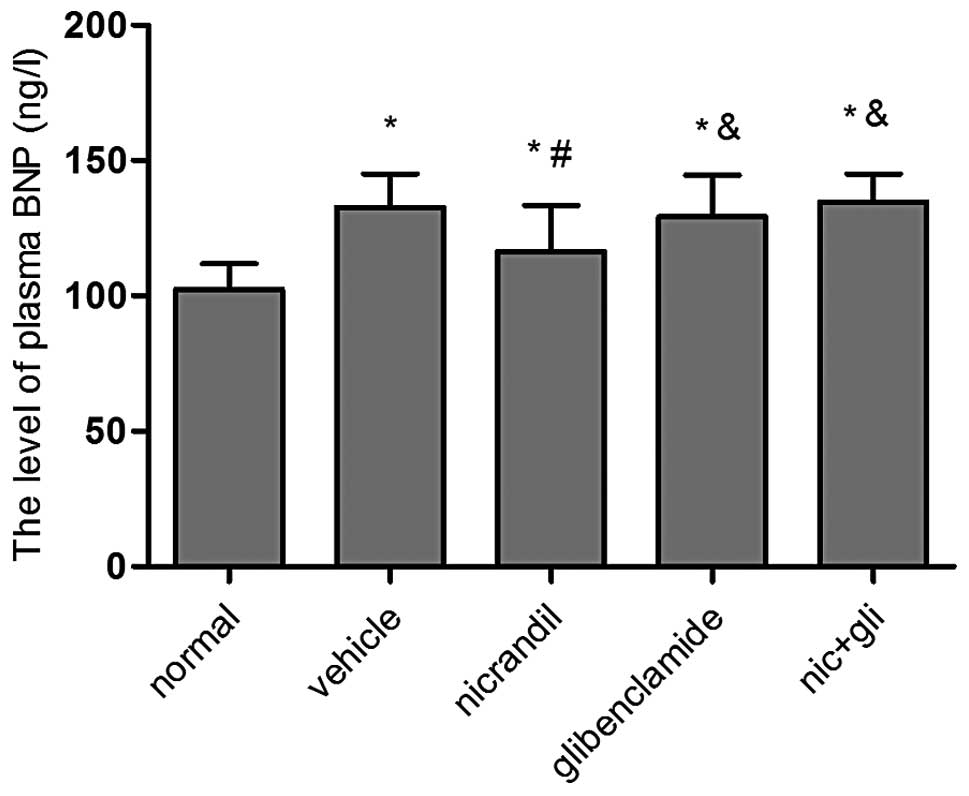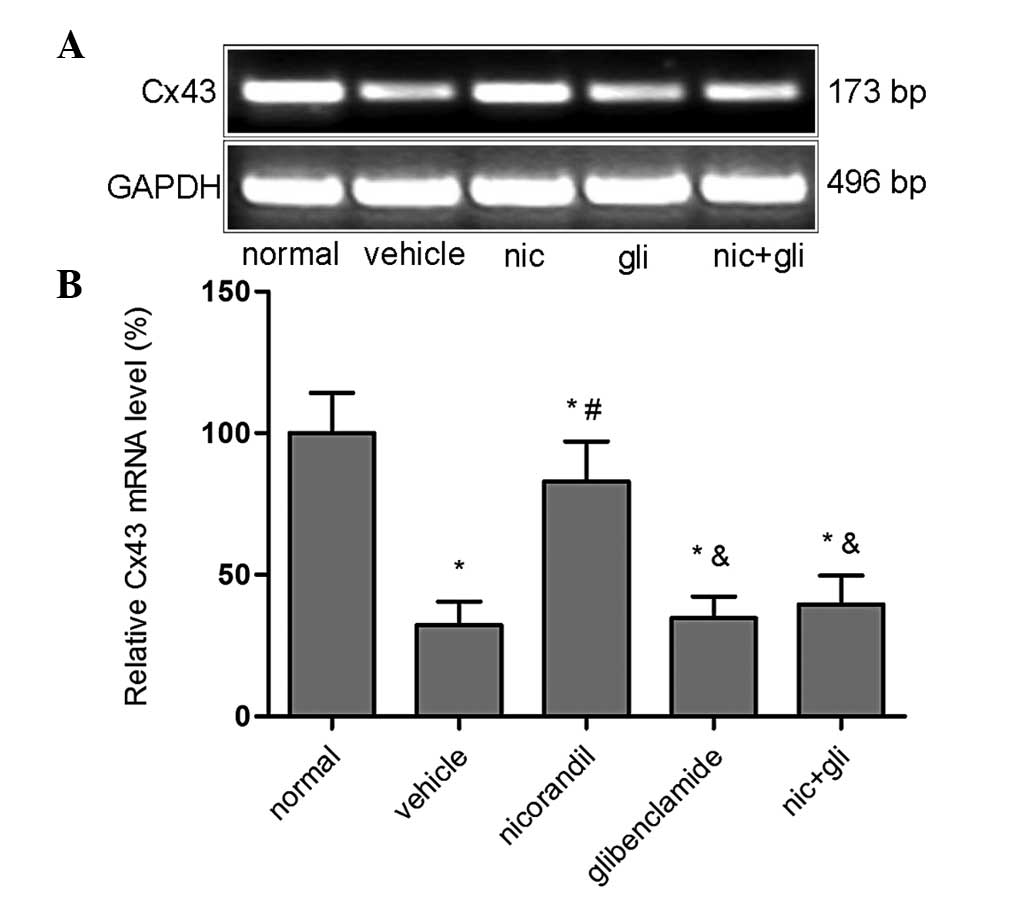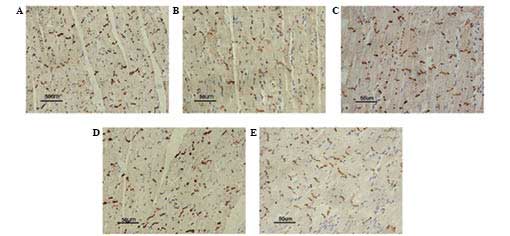|
1
|
Weber KT, Anversa P, Armstrong PW, et al:
Remodeling and reparation of the cardiovascular system. J Am Coll
Cardiol. 20:3–16. 1992. View Article : Google Scholar : PubMed/NCBI
|
|
2
|
Verdecchia P, Carini G and Circo A; MAVI
(MAssa Ventricolare sinistra nell'Ipertensione) Study Group. Left
ventricular mass and cardiovascular morbidity in essential
hypertension: the MAVI study. J Am Coll Cardiol. 38:1829–1835.
2001. View Article : Google Scholar : PubMed/NCBI
|
|
3
|
Choudhary R, Mishra KP and Subramanyam C:
Prevention of isoproterenol-induced cardiac hypertrophy by eugenol,
an antioxidant. Indian J Clin Biochem. 21:107–113. 2006. View Article : Google Scholar : PubMed/NCBI
|
|
4
|
Rajesh KG, Sasaguri S, Suzuki R, Xing Y
and Maeda H: Ischemic preconditioning prevents reperfusion heart
injury in cardiac hypertrophy by activation of mitochondrial KATP
channels. Int J Cardiol. 96:41–49. 2004. View Article : Google Scholar : PubMed/NCBI
|
|
5
|
Lee TM, Lin MS and Chang NC: Effect of
ATP-sensitive potassium channel agonists on ventricular remodeling
in healed rat infarcts. J Am Coll Cardio. 51:1309–1318. 2008.
View Article : Google Scholar
|
|
6
|
Ennis IL, Escudero EM, Console GM, et al:
Regression of isoproterenol-induced cardiac hypertrophy by
Na+/H+ exchanger inhibition. Hypertension.
41:1324–1329. 2003. View Article : Google Scholar : PubMed/NCBI
|
|
7
|
Frohlich ED: State of the Art lecture.
Risk mechanisms in hypertensive heart disease. Hypertension.
34:782–789. 1999. View Article : Google Scholar : PubMed/NCBI
|
|
8
|
Joyner RW: Effects of the discrete pattern
of electrical coupling on propagation through an electrical
syncytium. Circ Res. 50:192–200. 1982. View Article : Google Scholar : PubMed/NCBI
|
|
9
|
Danik SB, Liu F, Zhang J, Suk HJ, Morley
GE, Fishman GI and Gutstein DE: Modulation of cardiac gap junction
expression and arrhythmic susceptibility. Circ Res. 95:1035–1041.
2004. View Article : Google Scholar : PubMed/NCBI
|
|
10
|
Boengler K, Dodoni G, Rodriguez-Sinovas A,
et al: Connexin 43 in cardiomyocyte mitochondria and its increase
by ischemic preconditioning. Cardiovasc Res. 67:234–244. 2005.
View Article : Google Scholar : PubMed/NCBI
|
|
11
|
Roell W, Lewalter T, Sasse P, et al:
Engraftment of connexin 43-expressing cells prevents post-infarct
arrhythmia. Nature. 450:819–824. 2007. View Article : Google Scholar : PubMed/NCBI
|
|
12
|
Rottlaender D, Boengler K, Wolny M, et al:
Connexin 43 acts as a cytoprotective mediator of signal
transduction by stimulating mitochondrial KATP channels in mouse
cardiomyocytes. J Clin Invest. 120:1441–1453. 2010. View Article : Google Scholar : PubMed/NCBI
|
|
13
|
Wang A, Chen F, Xie Y, Guo Z and Yu Y:
Protective mechanism of nicorandil on rat myocardial
ischemia-reperfusion. J Cardiovasc Med (Hagerstown). 13:511–515.
2012. View Article : Google Scholar
|
|
14
|
de Lemos JA, McGuire DK and Drazner MH:
B-type natriuretic peptide in cardiovascular disease. Lancet.
362:316–322. 2003. View Article : Google Scholar : PubMed/NCBI
|
|
15
|
Tang Y, Wang M, Le X, et al: Antioxidant
and cardioprotective effects of Danshensu
(3-(3,4-dihydroxyphenyl)-2-hydroxy-propanoic acid from Salvia
miltiorrhiza) on isoproterenol-induced myocardial hypertrophy in
rats. Phytomedicine. 18:1024–1030. 2011. View Article : Google Scholar : PubMed/NCBI
|
|
16
|
Pfeffer MA and Braunwald E: Ventricular
remodeling after myocardial infarction. Experimental observations
and clinical implications. Circulation. 81:1161–1172. 1990.
View Article : Google Scholar : PubMed/NCBI
|
|
17
|
Sakai K: Nicorandil: animal pharmacology.
Am J Cardiol. 63:2J–10J. 1989. View Article : Google Scholar : PubMed/NCBI
|
|
18
|
Lee TM, Lin CC, Lien HY and Chen CC: K ATP
channel agonists preserve connexin43 protein in infarcted rats by a
protein kinase C-dependent pathway. J Cell Mol Med. 16:776–788.
2012. View Article : Google Scholar
|
|
19
|
Guéant Rodriguez RM, Spada R, Pooya S, et
al: Homocysteine predicts increased NT-pro-BNP through impaired
fatty acid oxidation. Int J Cardiol. 167:768–775. 2013. View Article : Google Scholar
|
|
20
|
Swedberg K, Cleland J, Dargie H, et al:
Task Force for the Diagnosis and Treatment of Chronic Heart Failure
of the European Society of Cardiology: Guidelines for the diagnosis
and treatment of chronic heart failure: executive summary (update
2005): The Task Force for the Diagnosis and Treatment of Chronic
Heart Failure of the European Society of Cardiology. Eur Heart J.
26:1115–1140. 2005. View Article : Google Scholar : PubMed/NCBI
|
|
21
|
Kimura T, Kitamura H, Inoue K, et al:
Effects of nicorandil on the reduction of BNP levels in patients
with chronic kidney disease. Clin Exp Nephrol. 15:854–860. 2011.
View Article : Google Scholar : PubMed/NCBI
|
|
22
|
Kanno S and Saffitz JE: The role of
myocardial gap junctions in electrical conduction and
arrhythmogenesis. Cardiovasc Pathol. 10:169–177. 2001. View Article : Google Scholar : PubMed/NCBI
|
|
23
|
Egashira K, Nishii K, Nakamura K, Kumai M,
Morimoto S and Shibata Y: Conduction abnormality in gap junction
protein connexin45-deficient embryonic stem cell-derived cardiac
myocytes. Anat Rec A Discov Mol Cell Evol Biol. 280:973–979. 2004.
View Article : Google Scholar : PubMed/NCBI
|
|
24
|
Wang Y and Hill JA: Electrophysiological
remodeling in heart failure. J Mol Cell Cardiol. 48:619–632. 2010.
View Article : Google Scholar : PubMed/NCBI
|
|
25
|
Ohara T, Ohara K, Cao JM, et al: Increased
wave break during ventricular fibrillation in the epicardial border
zone of hearts with healed myocardial infarction. Circulation.
103:1465–1472. 2001. View Article : Google Scholar : PubMed/NCBI
|
|
26
|
Naitoh K, Ichikawa Y, Miura T, et al:
MitoKATP channel activation suppresses gap junction
permeability in the ischemic myocardium by an ERK-dependent
mechanism. Cardiovasc Res. 70:374–383. 2006. View Article : Google Scholar : PubMed/NCBI
|
|
27
|
Amino M, Yoshioka K, Tanabe T, et al:
Heavy ion radiation up-regulates Cx43 and ameliorates
arrhythmogenic substrates in hearts after myocardial infarction.
Cardiovasc Res. 72:412–421. 2006. View Article : Google Scholar : PubMed/NCBI
|
|
28
|
Döring G: Antianginal and anti-ischemic
efficacy of nicorandil in comparison with isosorbide-5-mononitrate
and isosorbide dinitrate: results from two multicenter,
double-blind, randomized studies with stable coronary heart disease
patients. J Cardiovasc Pharmacol. 20(Suppl 3): S74–S81. 1992.
View Article : Google Scholar : PubMed/NCBI
|
|
29
|
The SWAN Study Group. Comparison of the
antiischaemic and antianginal effects of nicorandil and amlodipine
in patients with symptomatic stable angina pectoris: the SWAN
study. J Clin Basic Cardiol. 2:213–217. 1999.
|
|
30
|
Di Somma S, Liguori V, Petitto M,
Carotenuto A, Bokor D, de Divitiis O and de Divitiis M: A
double-blind comparison of nicorandil and metoprolol in stable
effort angina pectoris. Cardiovasc Drugs Ther. 7:119–123. 1993.
View Article : Google Scholar : PubMed/NCBI
|
|
31
|
Zhu WL, Shan YD, Guo JX, et al:
Double-blind, multicenter, active-controlled, randomized clinical
trial to assess the safety and efficacy of orally administered
nicorandil in patients with stable angina pectoris in China. Circ
J. 71:826–833. 2007. View Article : Google Scholar : PubMed/NCBI
|
|
32
|
Baines CP, Liu GS, Birincioglu M, Critz
SD, Cohen MV and Downey JM: Ischemic preconditioning depends on
interaction between mitochondrial KATP channels and actin
cytoskeleton. Am J Physiol. 276:H1361–H1368. 1999.PubMed/NCBI
|
|
33
|
Sugimoto K, Ito H, Iwakura K, et al:
Intravenous nicorandil in conjunction with coronary reperfusion
therapy is associated with better clinical and functional outcomes
in patients with acute myocardial infarction. Circ J. 67:295–300.
2003. View Article : Google Scholar : PubMed/NCBI
|
|
34
|
Garlid KD, Paucek P, Yarov-Yarovoy V, et
al: Cardioprotective effect of diazoxide and its interaction with
mitochondrial ATP-sensitive K+ channels. Possible
mechanism of cardioprotection. Circ Res. 81:1072–1082. 1997.
View Article : Google Scholar : PubMed/NCBI
|












